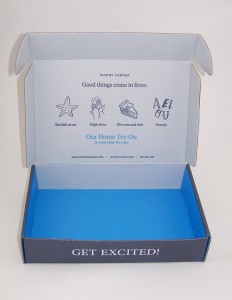As a result of dramatically increased shipping rates and costs, many shippers today are looking for ways to reduce the overall package weight in an effort to reduce the shipping cost. Being over or under a particular weight (for example, one pound) can make a shipping cost difference of over two dollars per package. That is huge if you are shipping thousands of boxes per month.
After working with dozens of companies to accomplish lower shipping rates, we offer these possible solutions:
Using the best shipping container for your product
Here I often use clothing as an example because I don’t understand why anyone would want to use a box if they don’t have to. The fact is that most clothing and soft goods can ship in paper or plastic mailer envelopes, eliminating the box as well as the void fill or other ancillary packaging that may be required. Keep in mind, void fill not only adds purchase, inbound shipping and storage cost, but also adds weight.
 Right sizing can lead to big packaging cost and weight reductions
Right sizing can lead to big packaging cost and weight reductions
This may be the most obvious advice I provide but you would be surprised at how many shippers are using boxes that are too large because that size is a “stock” size for their supplier, or because they occasionally get a larger order that requires the larger shipping box. For example, our 7x7x2 die cut corrugated mailer box weighs 3.1 ounces. Our smaller 5x5x2 mailer weighs 2.1 ounces. Using a smaller, size appropriate corrugated box also results in inbound shipping cost and storage savings.
Weight reduction by using thinner board
If you would like to use a smaller flute board to make your boxes to make them look more retail and less industrial, that is a great idea, but in most cases it does NOT reduce the weight of the box.
We have been involved in many cost analysis and in almost all cases, there is no significant weight reduction. In some cases there could actually be an increase in weight when you go from C flute to B flute or even from B flute to E or F flute corrugated board. As the photo shows, even though the overall board thickness is reduced because flutes are smaller and thinner, there are more of them, resulting in approximately the same weight.
However, we have been able to deliver significant weight savings by modifying the construction of the board and using either thinner paper inside or outside or even a lighter medium. This can get rather complicated but suffice to say that we know how to accomplish the objective without compromising the container’s integrity or the graphics that are printed on it. Keep in mind that for some “non-standard” paper and board combinations, minimums may apply, but if you are shipping more than a few thousand boxes per month, you likely qualify for the lighter board combinations.
Weight reduction by container design
We have done much work in this area reducing the overall board usage (square inches minus scrap) significantly by using an Eco Mailer Box design or Indestructo design but neither of those are guaranteed to reduce the weight of the finished box. Front lock versus top tuck, dust flaps versus no dust flaps, can all impact shipping weight if it is done properly. (See related posts at the end of this post)
Remember that the container being used still has to keep the product safe as it ships from point A to point B and that probably none of these options are a stand-alone solution. No two shipping and packing applications are identical so we will review the overall application to determine the best way to reduce the desired weight. In many cases, substantial weight reductions are best made possible by using a combination of box manufacturing techniques.
Contact Salazar Packaging or call us at 630-551-1700 for a no cost, no obligation review of your needs.
Related posts:
https://www.salazarpackaging.com/sustainable-products/b-flute-vs-c-flute-sustainably-equal-almost/

